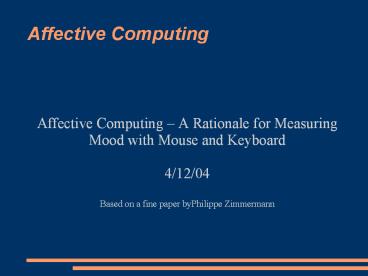Affective Computing - PowerPoint PPT Presentation
Title:
Affective Computing
Description:
Affective Computing. Affective Computing A Rationale for Measuring Mood with ... An intense experience of short duration. Can cause moods ... – PowerPoint PPT presentation
Number of Views:51
Avg rating:3.0/5.0
Title: Affective Computing
1
Affective Computing
- Affective Computing A Rationale for Measuring
Mood with Mouse and Keyboard - 4/12/04
- Based on a fine paper byPhilippe Zimmermann
2
Outline
- Introduction
- Affect, Emotion, Mood
- Structure and Labeling of Affect
- Mood Measurement Methods
- Mood Induction Methods
- Discussion
- Method
- Analysis
- Conclusions
3
Introduction
- Measure User Affect
- Use non-invasive, unobtrusive measurement method
- Use standard computer devices (Mouse, Keyboard)
- Extract data from log files of mouse and keyboard
movements to analyze correlations with affective
state
4
Affect, Emotion, Mood
- Affect - refers to either an emotion or a mood
- Emotion A reaction to a specific cause or
stimulus. An intense experience of short
duration. Can cause moods - Mood Subtle, longer lasting, more in the
background affective state of the user - An affective computer can take advantage of mood
by presenting stimuli that sustain a certain
mood, or counteract undesired moods. - Frustrated users could be prompted to take a
break - E-Commerce website could take advantage of the
study that said a low-risk purchase is more
likely while in a good mood, and a high-risk
purchase is more likely in a neutral or negative
mood
5
Structure and Labeling of Affect
- Three basic emotional dimensions
- Affective Valence (pleasure)
- Positive (Pleasant) to Negative (unpleasant)
- Arousal
- Calm (low-arousal) to Excited (high-arousal)
- Dominance (control)
- Controlled to In Control
6
Mood Measurement Methods
- Physiological
- Heart Rate, Blood Pressure, Respiration, Muscle
Action - Psychological
- Self Reports - Verbal, Ckecklists, Questionaires
- Behavioral
- Facial expressions, Gestures, Movement
- Studies show relation of mouse click patterns to
user frustration
7
Mood Induction Methods
- Mood changed by reading statements
- This method results in a short term mood change
- Mood changed by watching video with audio
- This results in a longer mood change
8
Discussion
- Physiological Signals will distract the user too
much (You need wires connected to you to gather
data such as heart rate and blood pressure) - Self Reports of current mood can be inaccurate as
the questions asked of the user to determine mood
might invoke a mood. - Using only a keyboard and a mouse will be
non-invasive, and should not have the ability to
change the users mood.
9
Method
- Film clips were used to induce moods.
- After watching the clip, the users were prompted
with a brief survey on their computer to rate
their current mood. - Users were required to shop on an e-commerce
website. - Physiological (pulse, respiration, etc) data was
taken. - Mouse and keyboard movements were recorded in the
background to a log file. Button Up/Down, mouse
coordinates, and what key pressed were logged
10
Method (2)
- Users Filled out the mood survey, watched the
clip, shopped the e-commerce site, and then
filled out the survey again. - The experiment lasted 1.5 to 2 hours
11
Analysis
- Using the physiological data and the surveys, the
user's mood will be verified to be one of the 5
different affective states - The log files with the Keyboard and Mouse log
files will be examined with the known mood
changes to look for patterns. - Number of mouse clicks per minute
- Duration of mouse clicks
- Distance of a single mouse movement
- Number and length of pauses in movement
- Minimum/Maximum/Average mouse speed
- Keystroke rate per second
- Average Duration of Keystroke
12
Conclusion
- If a system knows how a user feels it can
appropriately react to those moods - Questions
- Should a system try to change your mood?
- What emotions should Human Computer Interaction
be concerned? - How Accurate does the measurement have to be?



























![Global Affective Computing Market : Company Profiles, Market Opportunities and Forecast [2015 – 2021] PowerPoint PPT Presentation](https://s3.amazonaws.com/images.powershow.com/8310227.th0.jpg?_=201512040612)



